ACC03043: Corporate Governance Report on Collapses and Crisis
VerifiedAdded on 2022/11/13
|5
|1343
|476
Report
AI Summary
This report examines the critical aspects of corporate governance by analyzing two key areas: early corporate collapses in Australia and the implications of the 2008 global financial crisis. The first section delves into the failures of Rothwells Ltd., Bond Corporation Holdings Limited, and the Girvan Corporation, highlighting issues such as financial mismanagement, concealment of information, and breaches of stakeholder interests. It assesses whether modern corporate governance codes could have prevented these outcomes, emphasizing the evolution of corporate governance practices to address these failures. The second section explores the corporate governance implications stemming from the global financial crisis, focusing on the failures of financial institutions like Northern Rock Bank and AIG. It analyzes the role of risky decisions, executive compensation, and inadequate risk management, as well as the subsequent changes in corporate governance to protect stakeholders, including strengthened shareholder influence, defined roles for executives and board chairs, and enhanced risk management practices. The report concludes by underscoring the continuous evolution of corporate governance to safeguard against future systemic risks.
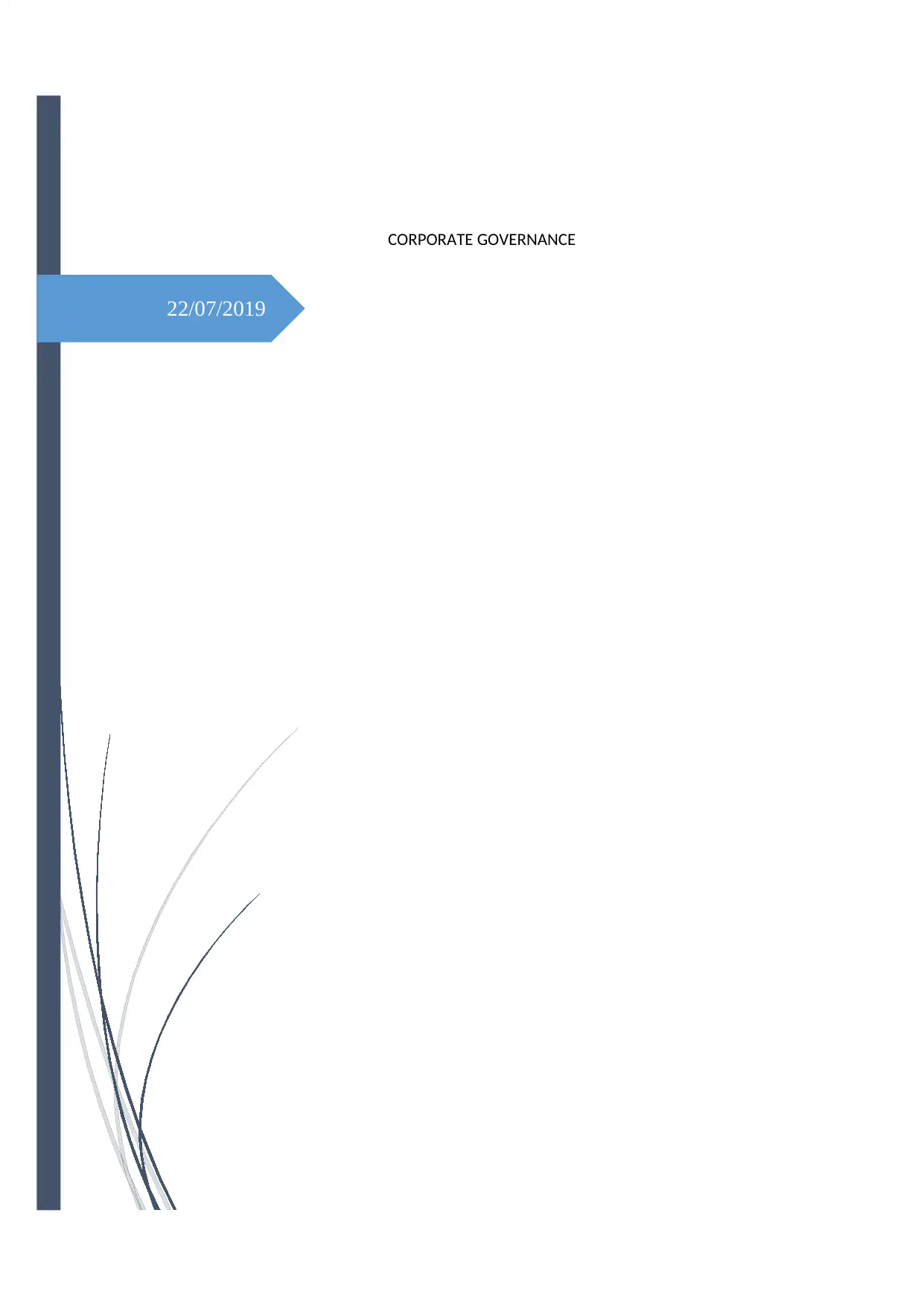
22/07/2019
CORPORATE GOVERNANCE
CORPORATE GOVERNANCE
Paraphrase This Document
Need a fresh take? Get an instant paraphrase of this document with our AI Paraphraser
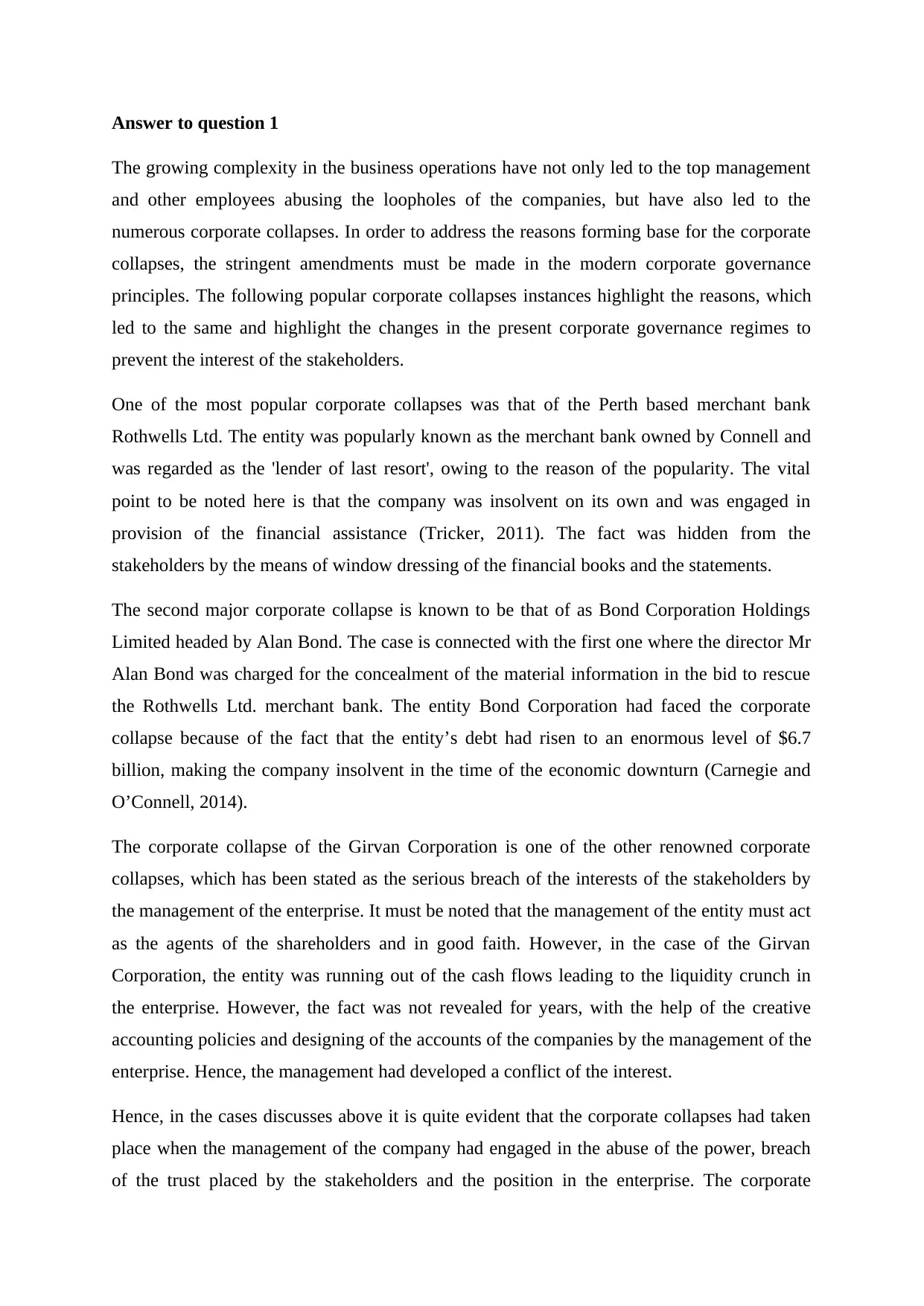
Answer to question 1
The growing complexity in the business operations have not only led to the top management
and other employees abusing the loopholes of the companies, but have also led to the
numerous corporate collapses. In order to address the reasons forming base for the corporate
collapses, the stringent amendments must be made in the modern corporate governance
principles. The following popular corporate collapses instances highlight the reasons, which
led to the same and highlight the changes in the present corporate governance regimes to
prevent the interest of the stakeholders.
One of the most popular corporate collapses was that of the Perth based merchant bank
Rothwells Ltd. The entity was popularly known as the merchant bank owned by Connell and
was regarded as the 'lender of last resort', owing to the reason of the popularity. The vital
point to be noted here is that the company was insolvent on its own and was engaged in
provision of the financial assistance (Tricker, 2011). The fact was hidden from the
stakeholders by the means of window dressing of the financial books and the statements.
The second major corporate collapse is known to be that of as Bond Corporation Holdings
Limited headed by Alan Bond. The case is connected with the first one where the director Mr
Alan Bond was charged for the concealment of the material information in the bid to rescue
the Rothwells Ltd. merchant bank. The entity Bond Corporation had faced the corporate
collapse because of the fact that the entity’s debt had risen to an enormous level of $6.7
billion, making the company insolvent in the time of the economic downturn (Carnegie and
O’Connell, 2014).
The corporate collapse of the Girvan Corporation is one of the other renowned corporate
collapses, which has been stated as the serious breach of the interests of the stakeholders by
the management of the enterprise. It must be noted that the management of the entity must act
as the agents of the shareholders and in good faith. However, in the case of the Girvan
Corporation, the entity was running out of the cash flows leading to the liquidity crunch in
the enterprise. However, the fact was not revealed for years, with the help of the creative
accounting policies and designing of the accounts of the companies by the management of the
enterprise. Hence, the management had developed a conflict of the interest.
Hence, in the cases discusses above it is quite evident that the corporate collapses had taken
place when the management of the company had engaged in the abuse of the power, breach
of the trust placed by the stakeholders and the position in the enterprise. The corporate
The growing complexity in the business operations have not only led to the top management
and other employees abusing the loopholes of the companies, but have also led to the
numerous corporate collapses. In order to address the reasons forming base for the corporate
collapses, the stringent amendments must be made in the modern corporate governance
principles. The following popular corporate collapses instances highlight the reasons, which
led to the same and highlight the changes in the present corporate governance regimes to
prevent the interest of the stakeholders.
One of the most popular corporate collapses was that of the Perth based merchant bank
Rothwells Ltd. The entity was popularly known as the merchant bank owned by Connell and
was regarded as the 'lender of last resort', owing to the reason of the popularity. The vital
point to be noted here is that the company was insolvent on its own and was engaged in
provision of the financial assistance (Tricker, 2011). The fact was hidden from the
stakeholders by the means of window dressing of the financial books and the statements.
The second major corporate collapse is known to be that of as Bond Corporation Holdings
Limited headed by Alan Bond. The case is connected with the first one where the director Mr
Alan Bond was charged for the concealment of the material information in the bid to rescue
the Rothwells Ltd. merchant bank. The entity Bond Corporation had faced the corporate
collapse because of the fact that the entity’s debt had risen to an enormous level of $6.7
billion, making the company insolvent in the time of the economic downturn (Carnegie and
O’Connell, 2014).
The corporate collapse of the Girvan Corporation is one of the other renowned corporate
collapses, which has been stated as the serious breach of the interests of the stakeholders by
the management of the enterprise. It must be noted that the management of the entity must act
as the agents of the shareholders and in good faith. However, in the case of the Girvan
Corporation, the entity was running out of the cash flows leading to the liquidity crunch in
the enterprise. However, the fact was not revealed for years, with the help of the creative
accounting policies and designing of the accounts of the companies by the management of the
enterprise. Hence, the management had developed a conflict of the interest.
Hence, in the cases discusses above it is quite evident that the corporate collapses had taken
place when the management of the company had engaged in the abuse of the power, breach
of the trust placed by the stakeholders and the position in the enterprise. The corporate
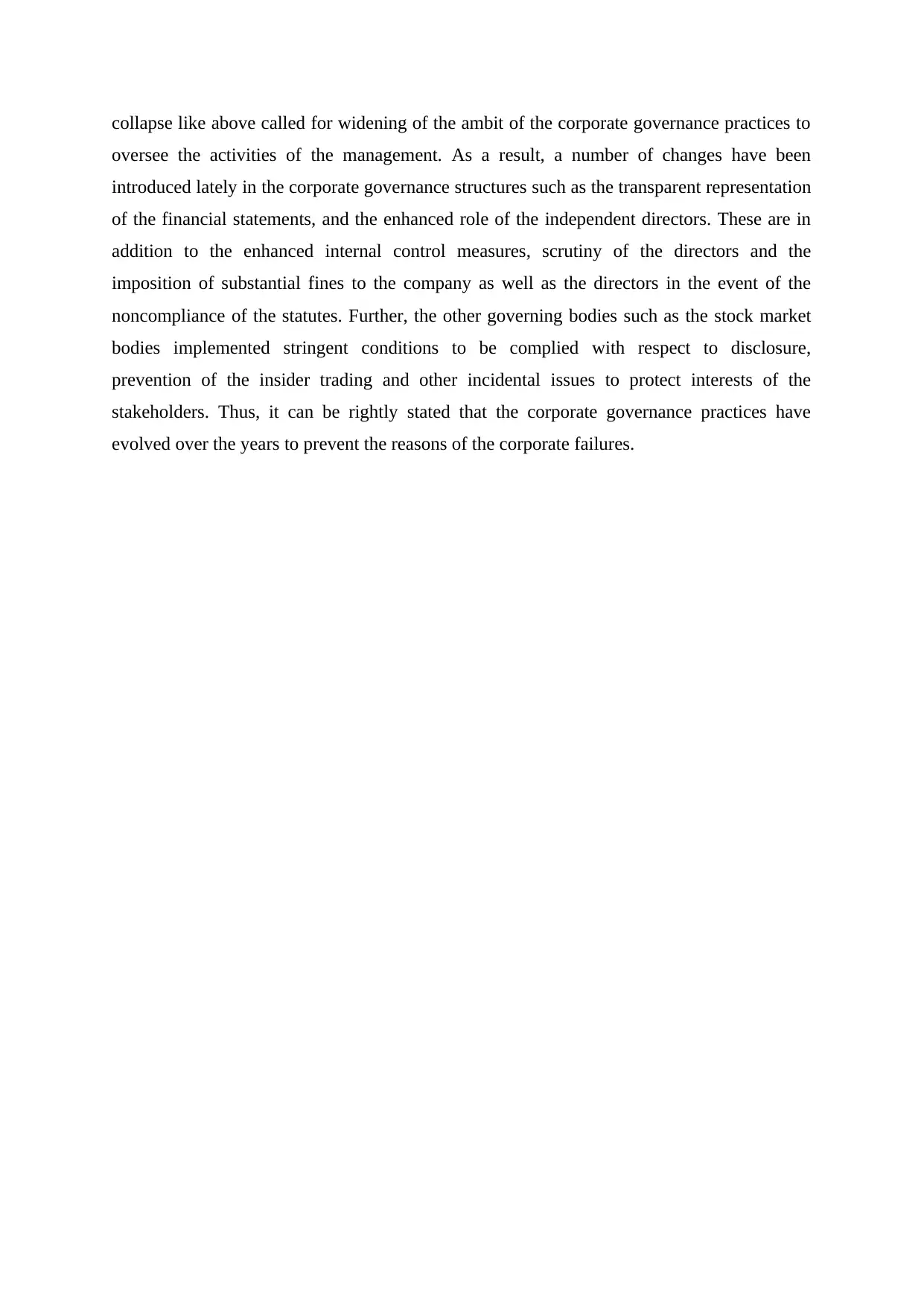
collapse like above called for widening of the ambit of the corporate governance practices to
oversee the activities of the management. As a result, a number of changes have been
introduced lately in the corporate governance structures such as the transparent representation
of the financial statements, and the enhanced role of the independent directors. These are in
addition to the enhanced internal control measures, scrutiny of the directors and the
imposition of substantial fines to the company as well as the directors in the event of the
noncompliance of the statutes. Further, the other governing bodies such as the stock market
bodies implemented stringent conditions to be complied with respect to disclosure,
prevention of the insider trading and other incidental issues to protect interests of the
stakeholders. Thus, it can be rightly stated that the corporate governance practices have
evolved over the years to prevent the reasons of the corporate failures.
oversee the activities of the management. As a result, a number of changes have been
introduced lately in the corporate governance structures such as the transparent representation
of the financial statements, and the enhanced role of the independent directors. These are in
addition to the enhanced internal control measures, scrutiny of the directors and the
imposition of substantial fines to the company as well as the directors in the event of the
noncompliance of the statutes. Further, the other governing bodies such as the stock market
bodies implemented stringent conditions to be complied with respect to disclosure,
prevention of the insider trading and other incidental issues to protect interests of the
stakeholders. Thus, it can be rightly stated that the corporate governance practices have
evolved over the years to prevent the reasons of the corporate failures.
⊘ This is a preview!⊘
Do you want full access?
Subscribe today to unlock all pages.

Trusted by 1+ million students worldwide
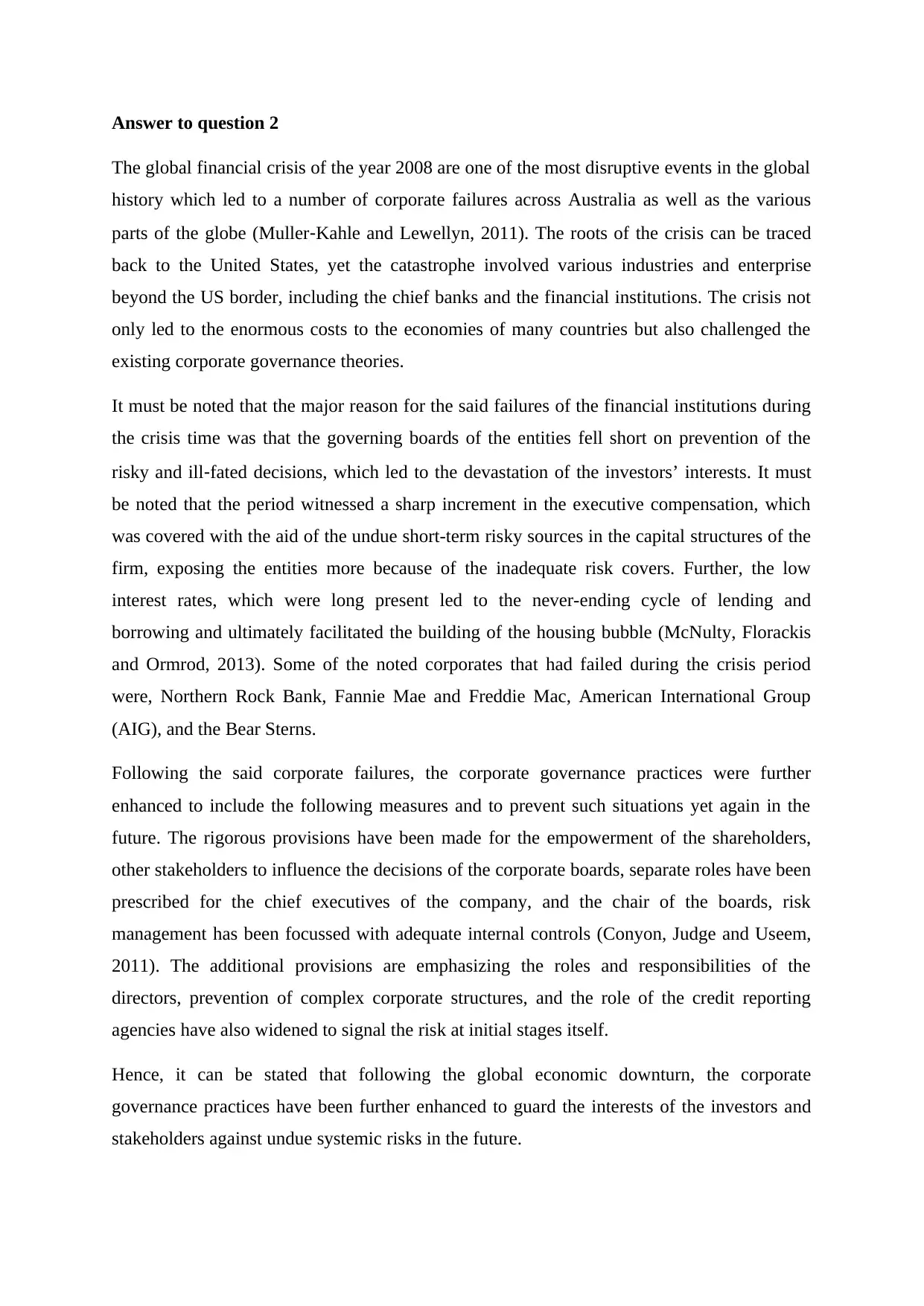
Answer to question 2
The global financial crisis of the year 2008 are one of the most disruptive events in the global
history which led to a number of corporate failures across Australia as well as the various
parts of the globe (Muller‐Kahle and Lewellyn, 2011). The roots of the crisis can be traced
back to the United States, yet the catastrophe involved various industries and enterprise
beyond the US border, including the chief banks and the financial institutions. The crisis not
only led to the enormous costs to the economies of many countries but also challenged the
existing corporate governance theories.
It must be noted that the major reason for the said failures of the financial institutions during
the crisis time was that the governing boards of the entities fell short on prevention of the
risky and ill‐fated decisions, which led to the devastation of the investors’ interests. It must
be noted that the period witnessed a sharp increment in the executive compensation, which
was covered with the aid of the undue short-term risky sources in the capital structures of the
firm, exposing the entities more because of the inadequate risk covers. Further, the low
interest rates, which were long present led to the never-ending cycle of lending and
borrowing and ultimately facilitated the building of the housing bubble (McNulty, Florackis
and Ormrod, 2013). Some of the noted corporates that had failed during the crisis period
were, Northern Rock Bank, Fannie Mae and Freddie Mac, American International Group
(AIG), and the Bear Sterns.
Following the said corporate failures, the corporate governance practices were further
enhanced to include the following measures and to prevent such situations yet again in the
future. The rigorous provisions have been made for the empowerment of the shareholders,
other stakeholders to influence the decisions of the corporate boards, separate roles have been
prescribed for the chief executives of the company, and the chair of the boards, risk
management has been focussed with adequate internal controls (Conyon, Judge and Useem,
2011). The additional provisions are emphasizing the roles and responsibilities of the
directors, prevention of complex corporate structures, and the role of the credit reporting
agencies have also widened to signal the risk at initial stages itself.
Hence, it can be stated that following the global economic downturn, the corporate
governance practices have been further enhanced to guard the interests of the investors and
stakeholders against undue systemic risks in the future.
The global financial crisis of the year 2008 are one of the most disruptive events in the global
history which led to a number of corporate failures across Australia as well as the various
parts of the globe (Muller‐Kahle and Lewellyn, 2011). The roots of the crisis can be traced
back to the United States, yet the catastrophe involved various industries and enterprise
beyond the US border, including the chief banks and the financial institutions. The crisis not
only led to the enormous costs to the economies of many countries but also challenged the
existing corporate governance theories.
It must be noted that the major reason for the said failures of the financial institutions during
the crisis time was that the governing boards of the entities fell short on prevention of the
risky and ill‐fated decisions, which led to the devastation of the investors’ interests. It must
be noted that the period witnessed a sharp increment in the executive compensation, which
was covered with the aid of the undue short-term risky sources in the capital structures of the
firm, exposing the entities more because of the inadequate risk covers. Further, the low
interest rates, which were long present led to the never-ending cycle of lending and
borrowing and ultimately facilitated the building of the housing bubble (McNulty, Florackis
and Ormrod, 2013). Some of the noted corporates that had failed during the crisis period
were, Northern Rock Bank, Fannie Mae and Freddie Mac, American International Group
(AIG), and the Bear Sterns.
Following the said corporate failures, the corporate governance practices were further
enhanced to include the following measures and to prevent such situations yet again in the
future. The rigorous provisions have been made for the empowerment of the shareholders,
other stakeholders to influence the decisions of the corporate boards, separate roles have been
prescribed for the chief executives of the company, and the chair of the boards, risk
management has been focussed with adequate internal controls (Conyon, Judge and Useem,
2011). The additional provisions are emphasizing the roles and responsibilities of the
directors, prevention of complex corporate structures, and the role of the credit reporting
agencies have also widened to signal the risk at initial stages itself.
Hence, it can be stated that following the global economic downturn, the corporate
governance practices have been further enhanced to guard the interests of the investors and
stakeholders against undue systemic risks in the future.
Paraphrase This Document
Need a fresh take? Get an instant paraphrase of this document with our AI Paraphraser
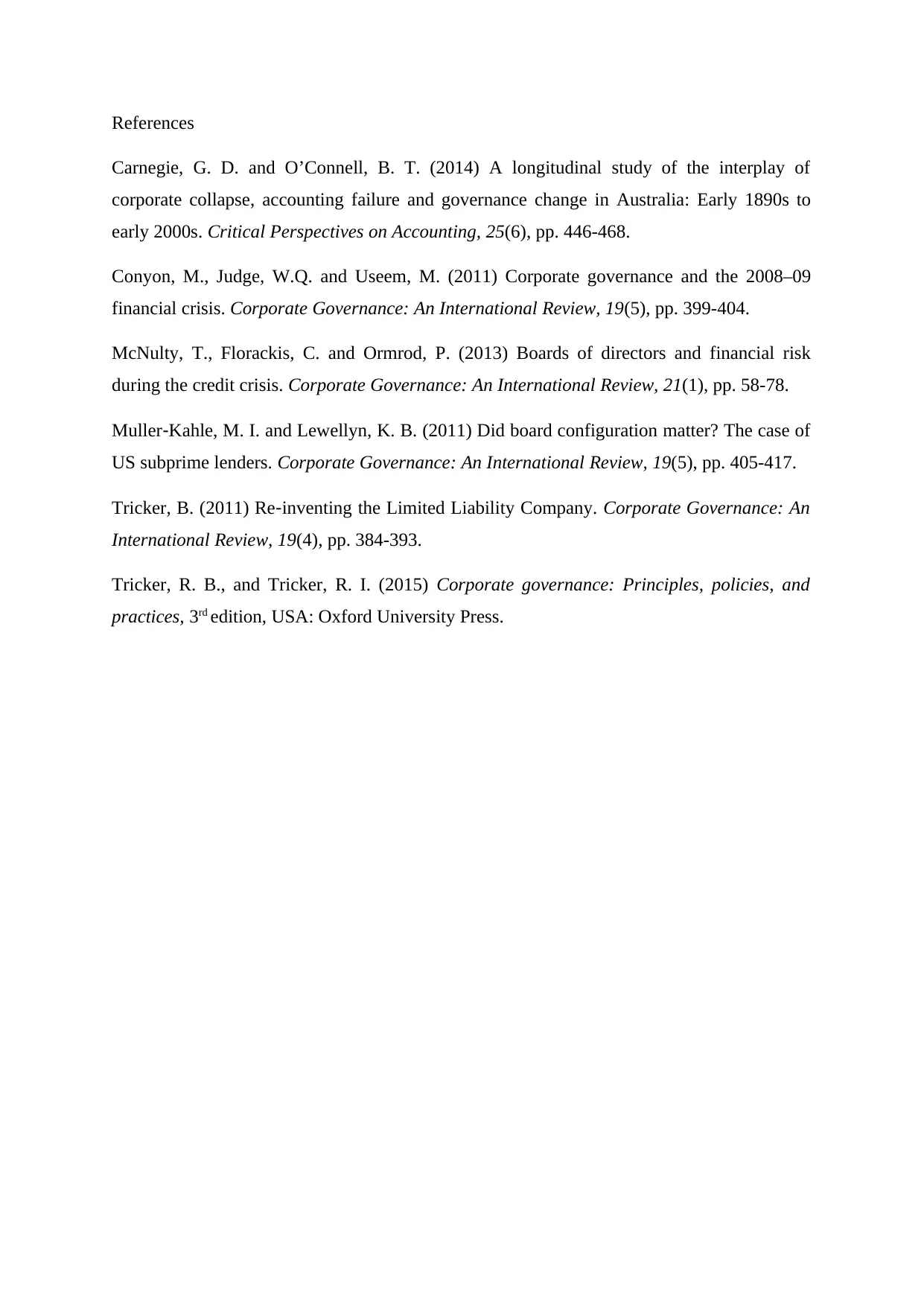
References
Carnegie, G. D. and O’Connell, B. T. (2014) A longitudinal study of the interplay of
corporate collapse, accounting failure and governance change in Australia: Early 1890s to
early 2000s. Critical Perspectives on Accounting, 25(6), pp. 446-468.
Conyon, M., Judge, W.Q. and Useem, M. (2011) Corporate governance and the 2008–09
financial crisis. Corporate Governance: An International Review, 19(5), pp. 399-404.
McNulty, T., Florackis, C. and Ormrod, P. (2013) Boards of directors and financial risk
during the credit crisis. Corporate Governance: An International Review, 21(1), pp. 58-78.
Muller‐Kahle, M. I. and Lewellyn, K. B. (2011) Did board configuration matter? The case of
US subprime lenders. Corporate Governance: An International Review, 19(5), pp. 405-417.
Tricker, B. (2011) Re‐inventing the Limited Liability Company. Corporate Governance: An
International Review, 19(4), pp. 384-393.
Tricker, R. B., and Tricker, R. I. (2015) Corporate governance: Principles, policies, and
practices, 3rd edition, USA: Oxford University Press.
Carnegie, G. D. and O’Connell, B. T. (2014) A longitudinal study of the interplay of
corporate collapse, accounting failure and governance change in Australia: Early 1890s to
early 2000s. Critical Perspectives on Accounting, 25(6), pp. 446-468.
Conyon, M., Judge, W.Q. and Useem, M. (2011) Corporate governance and the 2008–09
financial crisis. Corporate Governance: An International Review, 19(5), pp. 399-404.
McNulty, T., Florackis, C. and Ormrod, P. (2013) Boards of directors and financial risk
during the credit crisis. Corporate Governance: An International Review, 21(1), pp. 58-78.
Muller‐Kahle, M. I. and Lewellyn, K. B. (2011) Did board configuration matter? The case of
US subprime lenders. Corporate Governance: An International Review, 19(5), pp. 405-417.
Tricker, B. (2011) Re‐inventing the Limited Liability Company. Corporate Governance: An
International Review, 19(4), pp. 384-393.
Tricker, R. B., and Tricker, R. I. (2015) Corporate governance: Principles, policies, and
practices, 3rd edition, USA: Oxford University Press.
1 out of 5
Related Documents
Your All-in-One AI-Powered Toolkit for Academic Success.
+13062052269
info@desklib.com
Available 24*7 on WhatsApp / Email
![[object Object]](/_next/static/media/star-bottom.7253800d.svg)
Unlock your academic potential
Copyright © 2020–2025 A2Z Services. All Rights Reserved. Developed and managed by ZUCOL.



